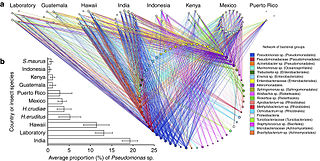Pseudomonas putida is a Gram-negative, rod-shaped, saprotrophic soil bacterium.

Halomonadaceae is a family of halophilic Pseudomonadota.
Pseudomonas avellanae is a Gram-negative plant pathogenic bacterium. It is the causal agent of bacterial canker of hazelnut. Based on 16S rRNA analysis, P. avellanae has been placed in the P. syringae group. This species was once included as a pathovar of Pseudomonas syringae, but following DNA-DNA hybridization, it was instated as a separate species. Following ribotypical analysis Pseudomonas syringae pv. theae was incorporated into this species.
Pseudomonas brassicacearum is a Gram-negative soil bacterium that infects the roots of Brassica napus, from which it derives its name. Based on 16S rRNA analysis, P. brassicacearum falls within the P. fluorescens group. It has also been shown to have both pathogenic and plant growth-promoting effects on tomato plants.

Pseudomonas fulva is a Gram-negative environmental bacterium, originally isolated from rice and commonly associated with rice plants, grains and paddy fields. It is rod-shaped and motile using one to three polar flagella.
Pseudomonas segitis is a Gram-negative, aerobic soil bacterium found in Korea. The type strain is IMSNU 14101.
Pseudomonas moraviensis is a Gram-negative soil bacterium. It is named after Moravia, the region of the Czech Republic where it was first isolated. The type strain is CCM 7280T.
Pseudomonas vranovensis is a Gram-negative soil bacterium.
Pseudomonas salomonii is a Gram-negative bacterium that infects garlic. The type strain is CFBP 2022.
Pseudomonas trivialis is a fluorescent, Gram-negative bacterium isolated from the phyllosphere of grasses. The type strain is DSM 14937.
Pseudomonas poae is a fluorescent, Gram-negative bacterium isolated from the phyllosphere of grasses. The type strain is DSM 14936.
Pseudomonas congelans is a fluorescent, Gram-negative bacterium isolated from the phyllosphere of grasses. The type strain is DSM 14939.
Pseudomonas amygdali is a Gram-negative plant pathogenic bacterium. It is named after its ability to cause disease on almond trees. Different analyses, including 16S rRNA analysis, DNA-DNA hybridization, and MLST clearly placed P. amygdali in the P. syringae group together with the species Pseudomonas ficuserectae and Pseudomonas meliae, and 27 pathovars of Pseudomonas syringae/Pseudomonas savastanoi, constituting a single, well-defined phylogenetic group which should be considered as a single species. This phylogenetic group has not been formally named because of the lack of reliable means to differentiate it phenotypically from closely related species, and it is currently known as either genomospecies 2 or phylogroup 3. When it is formally named, the correct name for this new species should be Pseudomonas amygdali, which takes precedence over all the other names of taxa from this group, including Pseudomonas savastanoi, which is and inadequate and confusing name whose use is not recommended.
Pseudomonas umsongensis is a Gram-negative, non-spore-forming, motile, single polar-flagellated, yellow-white, rod-shaped bacterium isolated from the soil in the Umsong region of Korea. The type strain is LMG 21317.
Pseudomonas gessardii is a fluorescent, Gram-negative, rod-shaped bacterium isolated from natural mineral waters in France. Based on 16S rRNA analysis, P. gessardii has been placed in the P. fluorescens group.
Pseudomonas antarctica is a psychrophilic, Gram-negative, motile with a polar flagellum, rod-shaped bacterium isolated from cyanobacterial mats in Antarctica.
Pseudomonas proteolytica is a psychrophilic, Gram-negative, motile with a polar flagellum, rod-shaped bacterium isolated from cyanobacterial mats in Antarctica.
Pseudomonas borbori is an aerobic, Gram-negative, nonfluorescent, nonsporulating, motile, rod-shaped bacterium isolated from a nitrifying inoculum used in aquaculture. Based on 16S rRNA phylogenetic analysis, P. borbori was placed in the P. aeruginosa group.
Pseudomonas costantinii is a Gram-negative bacterium that causes brown blotch disease in cultivated mushrooms. It demonstrates hemolytic activity. The type strain is CFBP 5705.
Pelomonas saccharophila is a Gram-negative soil bacterium. It was originally named Pseudomonas saccharophila in 1940, but was reclassified in 2005 to the newly created genus, Pelomonas. The original strain was isolated from mud.

